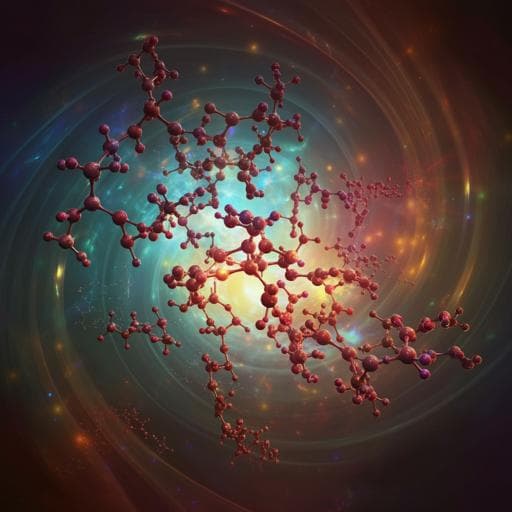
Chemistry
Stereodivergent synthesis of chiral succinimides via Rh-catalyzed asymmetric transfer hydrogenation
F. Wang, Z. Zhang, et al.
Discover a groundbreaking method for synthesizing 3,4-disubstituted succinimides using a dynamic kinetic resolution strategy. This innovative approach, championed by researchers Fangyuan Wang and colleagues, leverages a highly active Rh catalyst to achieve remarkable enantioselectivity and diastereoselectivity, providing separate access to *syn*- and *anti*-configured products. Embrace the future of enantioenriched succinimides with this stereodivergent technique!
~3 min • Beginner • English
Introduction
Succinimide-containing scaffolds, including 3-substituted and 3,4-disubstituted variants, are prevalent in natural products and drugs (e.g., antiepileptics such as phensuximide, methsuximide, ethosuximide) and exhibit diverse biological activities (antibacterial, antifungal, analgesic, anticonvulsant, antitumor). While enantioselective cycloadditions, hydrogenations of maleimides, and nucleophilic additions have enabled access to 3-substituted succinimides, efficient and general routes to 3,4-disubstituted, especially stereodivergent syntheses, remain scarce. 3-Hydroxy-4-substituted succinimides are versatile synthons convertible to chiral pyrrolidones and lactams, motivating new methods to construct them from simple feedstocks. Dynamic kinetic resolution via asymmetric transfer hydrogenation (DKR-ATH) has proven powerful for α-functionalized ketones; however, 3-hydroxy-4-substituted maleimides predominantly exist in the enol form, display low reactivity under basic ATH conditions, and their reduction products readily epimerize in base, complicating stereocontrol. The authors therefore sought a catalytic system and conditions to overcome these challenges and deliver stereodivergent access to chiral 3,4-disubstituted succinimides.
Literature Review
Established asymmetric routes to chiral succinimides include catalytic enantioselective cycloadditions and hydrogenations of maleimides, as well as asymmetric additions of nucleophiles to maleimides. DKR-ATH, since the pioneering Noyori/Ikariya systems using TsDPEN ligands, has broadly enabled highly enantioselective reductions of α-functional ketones, typically requiring base to promote transfer hydrogenation. Baiker and co-workers reported enantioselective hydrogenation of pyrrolidine-2,3,5-triones with Pt–cinchonidine to single-stereocenter 3,4-disubstituted succinimides, suggesting potential for related substrates. However, unlike α-keto carbonyls, 3-hydroxy-4-substituted maleimides are predominantly enolized, display low reducing activity under alkaline conditions, and can be reduced by Pd/C–H2 but not by NaBH4/MeOH. Furthermore, products can epimerize under base, hindering conventional ATH approaches. These gaps motivate development of stereodivergent ATH tailored to enolizable maleimides.
Methodology
The authors developed a Rh-catalyzed DKR-ATH of 3-hydroxy-4-substituted maleimides enabling diastereodivergent access to anti and syn 3-hydroxy-4-substituted succinimides by controlling the amount of base (Et3N) in formic acid-based hydrogen donor systems. Condition optimization: Using model substrate 1a at 25 °C in MeOH with HCO2H/Et3N (5:2), commercial TsDPEN-based catalysts were screened (2 mol%). Noyori Ru catalysts (R,R)-cat.1 and (S,S)-cat.2 showed <5% conversion. Ir (S,S)-cat.3 gave 23% conversion, 84% ee, 84:16 dr. Tethered catalysts cat.4 and cat.5 improved conversion and selectivity; (R,R)-cat.4: 99% conv., 96% ee, 90:10 dr; (R,R)-cat.5: 90% conv., 95% ee, 92:8 dr. The tethered Rh catalysts (R,R)-cat.6 and (S,S)-cat.6 were superior; (S,S)-cat.6 delivered anti-2a with 85% conv., 96% ee, 95:5 dr in MeOH. Solvent effects with (S,S)-cat.6 and HCO2H/Et3N (5:2): hexane gave <5% conv.; EtOH (71% conv., 93% ee, 97:3 dr), DCM (66% conv., 95% ee, 93:7 dr), THF (81% conv., 99% ee, 96:4 dr), dioxane (97% conv., 99% ee, 93:7 dr), toluene (>99% conv., 95% ee, 98:2 dr), EtOAc (>99% conv., 99% ee, 98:2 dr). Modulating base: decreasing Et3N to HCO2H/Et3N (2:0.02) in EtOAc inverted diastereoselectivity to syn (dr 2:98; ee 96%); using only HCO2H (2.0 equiv.) gave syn with <1:99 dr and 93% ee but required extended time. Alternative donors (iPrOH or HCO2Na) under basic conditions gave <5% conv. Standardized conditions: anti-selective: (S,S)-cat.6 (2 mol%), EtOAc, HCO2H/Et3N (5:2, azeotrope), 25 °C; syn-selective: (S,S)-cat.6 (2 mol%), EtOAc, HCO2H (2.0 equiv.) with Et3N (2 mol%), 25 °C. Substrate scope: Wide range of N-protected substrates furnished anti-products 2a–2g in 94–98% yields, 94:6→99:1 dr, 88→99% ee under anti conditions. C4-aryl substituents bearing para halides, CF3, Me, OMe (2h–2m) were compatible (88–97% yields, 90:10–99:1 dr, 96→99% ee); meta substituents gave 98% ee, 96:4 dr (2n); ortho-OMe and o-F gave slightly lower dr (2o–2p, 95–96% yields, 91:9 dr, 97% ee). Poly-OMe phenyl (2r) reached 99% ee, 99:1 dr. Heteroaryl (2-naphthyl, 2-furanyl, 3-indolyl; 2r–2t) were tolerated (92–95% yields, 84:16–99:1 dr, 97–99% ee). Syn-selective conditions delivered syn-products 3a–3g in 93–98% yields, 93:7→99:1 dr, 88–98% ee; diverse aryl substitutions (o/m/p halides, CF3, Me, OMe) afforded 3h–3q in 92–98% yields, 95:5–99:1 dr, up to >99% ee; 2-naphthyl (3r) gave 98% yield, >99:1 dr, 98% ee; indole (3s) 91% ee, 99:1 dr; furan (3t) 94% ee, 96:4 dr. For C4-alkyl substrates, using the azeotropic HCO2H/Et3N (5:2) delivered syn-products 3u–3x in up to 97% yields with >99:1 dr and 97–98% ee. N-unprotected substrates furnished syn 3y–3aa with 98→99% ee, >99:1 dr; at increased catalyst loading, both enol and imide were reduced to give 4y–4aa (4,5-dihydroxy-3-alkylpyrrolidin-2-ones) bearing three contiguous stereocenters with 98→99% ee, >99:1 dr. Gram-scale applications: 1u (1.24 g) reduced at S/C = 2000 (0.05 mol% cat) to 3u in 99% yield, 97% ee, >99:1 dr; subsequent steps afforded synthon Su (3-hydroxy-4-methylproline) relevant to echinocandin synthesis. 1w (1.20 g) at S/C = 1000 (0.1 mol%) gave 3w in 90% yield, 97% ee, >99:1 dr; 3w was converted to pyrrolidine and lactam derivatives in high yields with excellent stereocontrol. Mechanistic studies: Protecting the 3-OH (1a′) under standard conditions gave reduced selectivity (37–38% ee; 85:15–87:13 dr), indicating the 3-OH is important and a C=C reduction pathway is possible. Syn-3a epimerizes to anti-2a in HCO2H/Et3N (5:2), suggesting anti arises via base-promoted epimerization of syn. For N-unprotected 3y, further reduction to 4y was observed. Kinetics showed 1a reduces preferentially to 1a′; 1a initially forms syn which equilibrates to anti during reaction, whereas 1a′ yields mainly anti with little change in dr during reaction. pH-dependent keto–enol equilibrium showed enol content increases with acidity. DFT calculations with cat.6-derived active species indicate the favored pathway is C=O reduction: from the enol-bound intermediate int1, the free energy barrier to product via a-RS-TS1 is 15.0 kcal/mol, while the C=C pathway requires 21.1 kcal/mol. In the C=O pathway, a-RS-TS1 is favored over a-SS-TS1, a-SR-TS1, a-RR-TS1 by 6.2, 7.5, and 10.8 kcal/mol. In the C=C pathway, the enantio-/rate-determining proton transfer TS (SS-TS2) is more stable than RS-TS2, SR-TS2, RR-TS2 by 9.2, 12.7, and 2.6 kcal/mol. Overall, C=O reduction forms syn-product, which can epimerize to anti in the presence of Et3N; direct C=C reduction is disfavored.
Key Findings
- Developed a Rh-catalyzed DKR-ATH that provides stereodivergent access to syn- and anti-3-hydroxy-4-substituted succinimides by modulating base (Et3N) in HCO2H-based systems.
- Performance metrics: turnover numbers up to 2000 (S/C = 2000), enantioselectivity up to >99% ee, diastereoselectivity up to >99:1 dr; isolated yields commonly 88–99% across broad substrate scope.
- Optimal anti conditions: (S,S)-cat.6, EtOAc, HCO2H/Et3N (5:2, azeotrope), 25 °C, delivering anti with up to 99% ee and 98:2→99:1 dr (e.g., entry 14: >99% conv., 99% ee, 98:2 dr).
- Optimal syn conditions: (S,S)-cat.6, EtOAc, HCO2H (2.0 equiv.) with 2 mol% Et3N, 25 °C, delivering syn with <1:99 to 2:98 anti/syn dr and up to 96% ee (entry 15: 2:98 dr, 96% ee; entry 16: <1:99 dr, 93% ee with longer time).
- Alternative donors (iPrOH, HCO2Na) under basic conditions gave <5% conversion; hexane solvent also gave <5% conversion.
- Substrate scope includes diverse N-protecting groups and aryl/heteroaryl/alkyl C4 substituents; heterocycles (indole, furan, naphthyl) tolerated; N-unprotected substrates also effective.
- For N-unprotected substrates, tuning catalyst loading enables chemoselective sequential reduction of enol and imide to give 4,5-dihydroxy-3-alkylpyrrolidin-2-ones (4y–4aa) with 98→99% ee and >99:1 dr.
- Gram-scale reactions: 1u at 0.05 mol% catalyst (S/C = 2000) afforded 3u in 99% yield, 97% ee, >99:1 dr; 1w at 0.1 mol% gave 3w in 90% yield, 97% ee, >99:1 dr; downstream transformations proceeded in high yields with retention of stereochemistry.
- Mechanistic insight: experiments indicate initial syn formation followed by base-promoted epimerization to anti; 3-OH is critical for high ee; 1a reduces faster than 1a′; enol content increases with acidity. DFT supports a favored C=O reduction pathway (barrier 15.0 kcal/mol) over C=C reduction (21.1 kcal/mol), rationalizing observed selectivities. In the C=O pathway, the enantio-determining TS (a-RS-TS1) is 6.2–10.8 kcal/mol lower than competing TSs.
Discussion
The work addresses a long-standing challenge in accessing 3,4-disubstituted succinimides with control over both enantio- and diastereoselectivity. By leveraging a tethered Rh catalyst and modulating the base content in a formic acid transfer hydrogenation system, the authors achieve stereodivergent outcomes: syn products under low/base-free conditions and anti products under HCO2H/Et3N (5:2), with excellent ee and dr across a broad substrate range. Mechanistic experiments and DFT calculations converge on a C=O reduction pathway that generates syn products, which epimerize to anti under basic conditions, explaining the diastereodivergent control via Et3N. The method expands ATH from delivering a single stereochemical outcome to enabling programmable access to both diastereomers and, by catalyst enantiomer choice, all four stereoisomers. The demonstrated gram-scale reactions and downstream functionalizations highlight synthetic utility for medicinally relevant scaffolds (e.g., echinocandin intermediates).
Conclusion
A general, efficient, and stereodivergent Rh-catalyzed DKR-ATH of 3-hydroxy-4-substituted maleimides has been developed. Fine-tuning the Et3N content in HCO2H-mediated transfer hydrogenation toggles between syn and anti diastereomers, each obtained in high yields with up to >99% ee and >99:1 dr, and turnover numbers up to 2000. The approach tolerates diverse N-protecting groups and C4 substituents, including heteroaryl and alkyl groups, and extends to N-unprotected substrates where both enol and imide can be reduced to furnish tri-stereocenter products. Mechanistic and computational studies reveal a favored C=O reduction pathway, with syn-to-anti epimerization under basic conditions responsible for anti selectivity. This strategy overcomes the conventional limitation of single-outcome ATH, enabling access to all four stereoisomers of 3,4-disubstituted succinimides and providing valuable building blocks for complex molecule synthesis. Potential future directions include expanding to other enolizable imide systems, exploring alternative hydrogen donors and catalysts for broader conditions, and applying the stereodivergent paradigm to other heterocyclic frameworks.
Limitations
- Low reactivity observed in nonpolar solvent (hexane, <5% conversion) and with alternative hydrogen donors under basic conditions (iPrOH or HCO2Na, <5% conversion).
- Hydroxyl-protected substrates (1a′) gave significantly lower enantioselectivity (37–38% ee) and only moderate dr (85:15–87:13), indicating dependence on the free 3-OH group.
- When only formic acid (no Et3N) was used, extended reaction time was required to reach full conversion and a slight decrease in ee was noted for syn products.
- Products can epimerize under basic conditions, necessitating careful control of base to direct diastereoselectivity.
Related Publications
Explore these studies to deepen your understanding of the subject.







